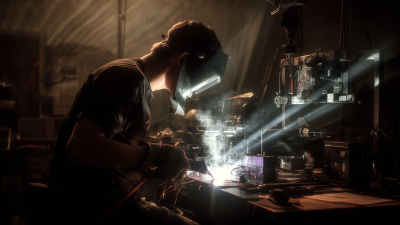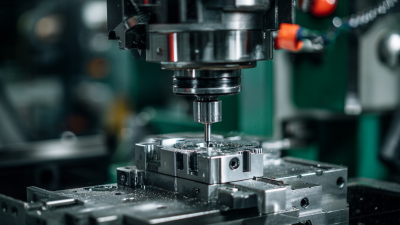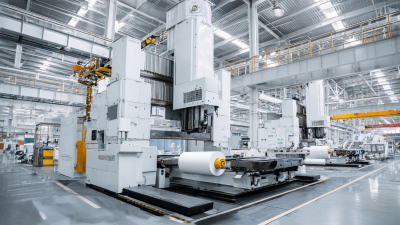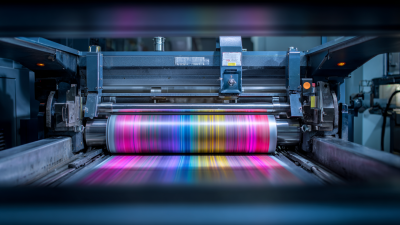Exploring the Future of Machine Welding Machines in Modern Manufacturing Techniques
The landscape of modern manufacturing is rapidly evolving, with Machine Welding Machines at the forefront of this transformation. As industries seek to enhance efficiency and precision, the demand for advanced welding technologies has surged. According to a report by MarketsandMarkets, the global welding equipment market is projected to reach $23.88 billion by 2025, with machine welding playing a pivotal role in this growth. The integration of automation and robotics in welding processes allows for increased productivity, reduced labor costs, and superior weld quality. As manufacturers embrace Industry 4.0 principles, the development of smart Machine Welding Machines that incorporate AI and IoT capabilities is set to redefine traditional methods, promising not only to meet the intricate demands of modern production but also to pave the way for sustainable practices and enhanced operational flexibility. This exploration delves into the future advancements and implications of Machine Welding Machines in today's manufacturing techniques.

Advancements in Machine Welding Technology: Shaping the Future of Manufacturing
The advancements in machine welding technology are revolutionizing the landscape of modern manufacturing. As industries strive for efficiency and precision, machine welding machines are evolving to meet these demands. State-of-the-art robotic systems are now equipped with artificial intelligence and machine learning capabilities, enabling them to adapt to various welding environments and materials. This evolution not only increases productivity by reducing reliance on manual labor but also enhances the overall quality and consistency of welds, minimizing defects and waste.
Moreover, the integration of IoT (Internet of Things) within welding machinery is paving the way for smarter manufacturing processes. Real-time data collection and analysis allow manufacturers to monitor welding conditions, predict maintenance needs, and optimize workflows. With advancements in automation, companies can achieve a higher degree of flexibility, allowing for the rapid reconfiguration of production lines to accommodate different product types. This level of adaptability will be crucial in a market that increasingly demands customized solutions and faster turnaround times.
As machine welding technology continues to advance, it will undeniably shape the future of manufacturing, driving innovation and redefining industry standards.
Integrating AI and Automation in Welding Processes: A Game Changer
The integration of artificial intelligence (AI) and automation in machine welding processes is revolutionizing modern manufacturing techniques. According to a recent report by MarketsandMarkets, the global market for automated welding is projected to reach USD 8.5 billion by 2025, growing at a CAGR of 4.2% from 2020 to 2025. This growth indicates a significant shift toward the incorporation of intelligent technology into manufacturing practices, enhancing productivity and precision.

AI systems in welding are enabling manufacturers to analyze real-time data, predict equipment failures, and optimize welding parameters, all of which contribute to reduced downtime and improved quality. For instance, a study published in the International Journal of Advanced Manufacturing Technology highlighted that implementing AI-driven welding robots reduced defect rates by up to 30%, showcasing the effectiveness of intelligent solutions. Furthermore, automated systems are not only aiding in traditional welding tasks but are also allowing for complex operations such as adaptive welding, which adjusts parameters dynamically based on material variations and environmental factors, thus increasing efficiency and reliability in production lines.
Sustainability and Efficiency: The Role of Digital Solutions in Welding
As modern manufacturing techniques evolve, the integration of digital solutions in the welding process has emerged as a paramount consideration for enhancing sustainability and efficiency. Digitalization allows for real-time monitoring and data collection, providing manufacturers with insights that can significantly reduce waste and energy consumption. By employing smart sensors and automated systems, welding machines can adjust their operations dynamically, optimizing parameters such as heat input and weld speed to achieve superior quality while minimizing material usage.

Moreover, the role of digital solutions extends beyond immediate operational benefits. Predictive maintenance powered by machine learning algorithms can foresee potential equipment failures, thereby reducing downtime and extending the life of welding machines. This proactive approach not only enhances productivity but also aligns with sustainability goals by minimizing the need for frequent replacements and repairs. In this landscape, the future of machine welding is closely tied to how effectively manufacturers can harness the capabilities of digital technologies to create a more efficient and environmentally friendly production process.
The Impact of Industry 4.0 on Machine Welding Operations
The integration of Industry 4.0 into machine welding operations is revolutionizing modern manufacturing techniques, enhancing efficiency and productivity. As per reports, the global market for welding machinery is projected to reach approximately $22.3 billion by 2030, exhibiting a compound annual growth rate (CAGR) of 6.3% from 2024. This growth reflects the increasing demand for advanced welding technologies, particularly in sectors like shipbuilding, automotive, and construction.
Moreover, the emergence of connected, digitalized solutions within the welding sector is facilitating data-driven manufacturing processes. Wire Arc Additive Manufacturing (WAAM), for example, showcases how integrating Internet of Things (IoT) principles with welding can streamline operations and yield higher quality outputs. The robotic welding market is also expanding rapidly, with significant investments in automation technologies that enhance precision and adaptability in production lines. This shift towards highly automated systems aligns with the overarching goals of Industry 4.0, aiming to create smarter, more responsive manufacturing environments capable of meeting the demands of the future.
Trends in Training and Skill Development for Modern Welding Techniques
The landscape of modern welding techniques is evolving rapidly, driven by technological advancements and changing industry demands. As machine welding machines become increasingly sophisticated, the need for skilled operators proficient in these new technologies is paramount. Training programs must adapt to encompass not only traditional welding skills but also advanced robotics, automation, and programming. Institutions and companies alike are enhancing their curricula to include hands-on training with the latest equipment, ensuring that the workforce is well-prepared for the challenges ahead.
Additionally, the integration of virtual reality (VR) and augmented reality (AR) in training modules is becoming more prevalent. These immersive technologies allow trainees to practice welding in realistic, simulated environments without the resource and safety concerns of real-world settings. This innovative approach not only enhances skill retention but also prepares future welders to navigate the complexities of modern machinery effectively. Emphasizing continuous skill development will ultimately lead to a more competent workforce that can leverage machine welding technologies to boost productivity and innovation in modern manufacturing practices.
Exploring the Future of Machine Welding Machines in Modern Manufacturing Techniques - Trends in Training and Skill Development for Modern Welding Techniques
| Dimension | Current Trends | Projected Growth (2024-2028) | Key Skills Required | Training Methods |
|---|---|---|---|---|
| Automation | Increasing use of robotic welding | 15% CAGR | Robotics programming, CAD | Online courses, workshops |
| Safety | Enhanced focus on safety training | 20% increase in safety certifications | Hazard analysis, PPE usage | Simulated training, e-learning |
| Sustainability | Environmentally friendly materials | 10% adoption by 2025 | Material science, recycling | On-site training, seminars |
| Digital Skills | Integration of IoT in welding | 25% growth in digital literacy courses | Data analysis, software tools | Hybrid training programs |
| Remote Monitoring | Rise in remote welding supervision | 30% increase in remote tools | Telecommunication skills | Video conferencing, remote demos |
Related Posts
-

Top Strategies for Sourcing the Best Welding Machines in the Global Market
-

2025 Trends: Unlocking the Secrets of the Best Industrial Milling Machines for Maximum Efficiency
-

Exploring Innovative Alternatives to the Best Industrial Packing Machine
-

Unleashing Excellence in Manufacturing with the Best Production Machine from China for Global Markets
-

Mastering the Best Production Machine for Your Manufacturing Success
-

Unlocking the Best Production Machine Technical Specifications and How to Maximize Efficiency
